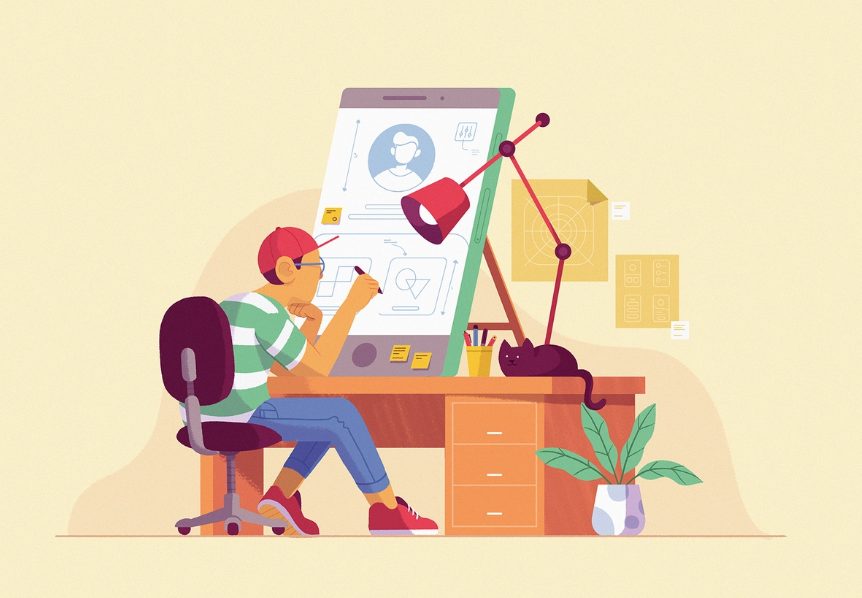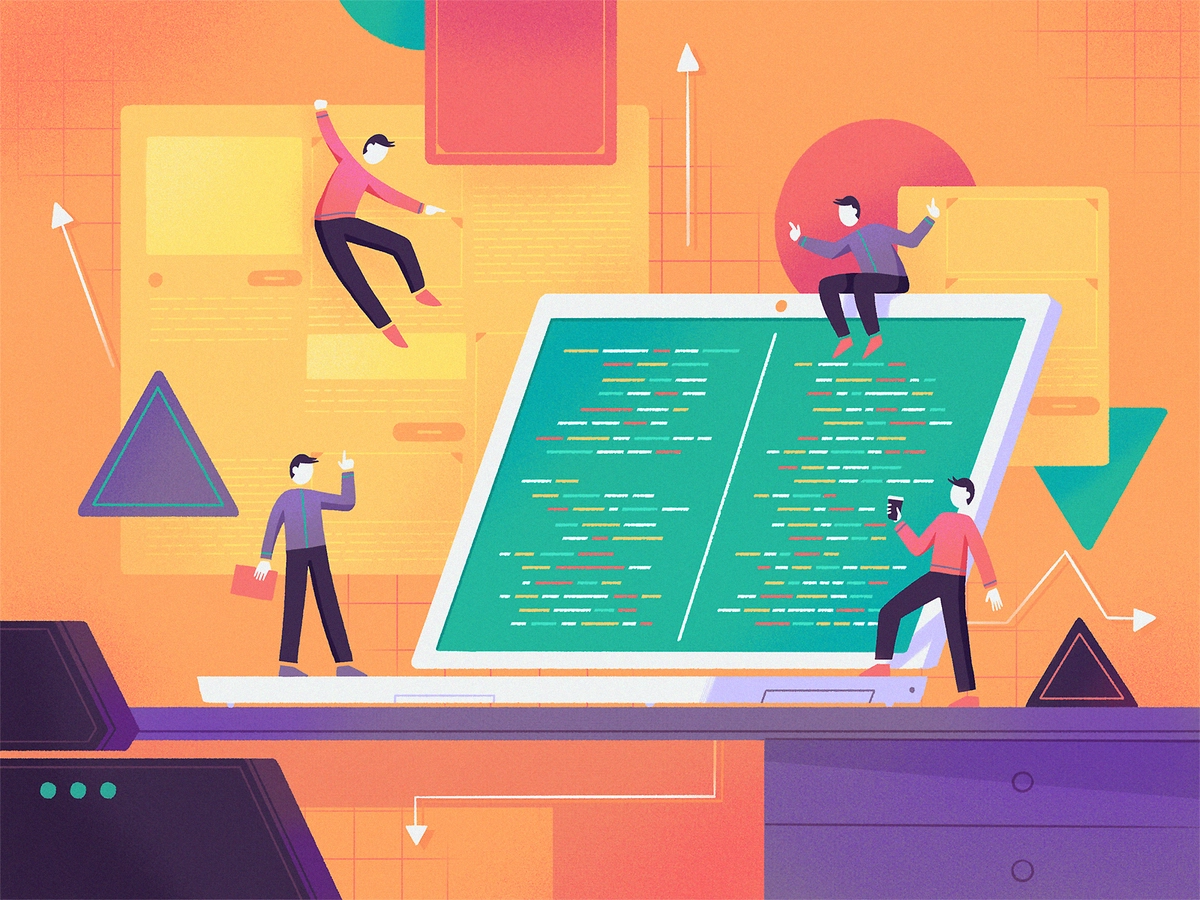Design Thinking Process Steps: 5 Stages of Design Thinking
By using design thinking, you make your product the key to solving user problems. You will work through every client’s pain and make your product truly valuable – people won’t need to give it up. Design thinking you apply has several stages to come through before you actually nail it up. Let’s revise 5 stages in the design thinking process right away.
What is Design Thinking?
To create convenient and useful products and services, you need to understand the needs of those for whom they are intended. Dive deep into the customer experience, ask the right questions, and solve problems creatively with design thinking. Besides, design thinking steps will be the user-centered approach to product development that involves non-standard problem-solving.
How the Design Thinking Process was Formed?
The idea of what is design thinking was first formed by Herbert A. Simon in The Sciences of the Artificial (1969). Later, this idea was developed at Stanford University, where the Stanford Design Institute was founded, which promoted the idea of design thinking.
We’ve also described the importance of a user-centric approach and business-driven digital design solutions for creating new products in our book Business-Driven Digital Product Design: Graphic Design in Brand Storytelling (2021). No doubt, design thinking is a core.

In some companies, such as Google, the design thinking process becomes a paradigm and even an ideology, where teams of researchers and developers use this method to come up with and test new ideas.
The goal of the Design Thinking Process
Design thinking involves immersion in the customer experience, a third-party approach to problem definition, focusing on personal scenarios of behavior and actions. The method assumes a creative but, at the same time, based on common sense, rethinking the users’ problems.
Thus, based on the design thinking process steps, we choose those ideas that are beneficial for our business and the client, which can really be turned into a final product. We create and test prototypes, and in the process of a series of iterations, we come to the release of a product that can solve the client’s problem and, accordingly, will be in demand on the market.
In the end, preventing the business from failing in the early development stage is among the key goals.
5 Stages of Design Thinking
The work within this approach is divided into 5 large stages. What are the 5 stages of design thinking? – Let’s see each phase in design thinking process.
Design Thinking Stage 1: Empathy
Empathy is the primary exploration & research. At this stage, we figure out what people are doing in order to solve a specific problem. For this, it is important for us to understand why they want to solve it, what their values are, and what their emotional and physical needs are. Our goal at this stage is to find answers to the following questions: what is the key problem of our client/product? What information do we need to solve a customer’s problem / make a product perfect? The user’s experience and the context it is located are examined, desires and motives are clarified, and requests are determined. The goal is to collect enough data to “feel in someone else’s shoes” and thereby understand the problems of the consumer.
To find answers to these questions, we use methods such as
- observation,
- searching for information in open sources,
- interviewing,
- experiments, etc.
At this stage, it is important to distinguish between the user’s desire and their true needs. For example, they may want a car that can travel 300 km per hour. The statement looks unrealistic, given that there are not many roads in the world where you can drive that fast. For a detailed study, the team conducts in-depth interviews and observes the user’s world and habits to set a design thinking framework. They also use secondary observation: they collect information about the user and the situation in open sources (social networks, the media and statistical reports, etc.)
If we dig deeper, we will get a person’s need for fast movement, which can be satisfied by buying a plane ticket or a high-speed train, etc.
Design Thinking Stage 2: Define
After the empathy, the researchers process all the information received and highlight the main problem of the user. The meaning of this step is to formulate a specific question for further work. It is important to formulate key observations and visualize them. For this, walls are often used, on which stickers with important finds are glued.
At this stage, we process the information received and form an overall picture. The purpose of focusing is to get the client’s question to which we need to find an answer.
Here, we may work with the so-called “persona-models” – the characteristic users of the product. We study their lifestyle, behavior, and needs in order to find the optimal solution to the problem.
Design Thinking Stage 3: Ideate
One of the 5 steps of design thinking is brainstorming and idea generation.
This is the stage of searching for multiple solutions to a single issue. Active group work produces brainstorming. They allow any insights and a variety of answers. A team of specialists from different profiles should gather in one room in order to fruitfully generate any concepts. At this stage, you cannot criticize and discard ideas.
We are thinking about ways of solving the problem. We conduct a brainstorming session, where each of the team members expresses as many ideas as they can think of. It is ideal if the team consists of specialists from different fields. The goal is to get as many ideas and approaches as possible.
During brainstorming sessions, it is important to be guided by the following rules:
- no criticism;
- help sprint colleagues develop ideas;
- consider even the most incredible and fantastic ideas;
- visualize;
- but do not stray from the topic;
Try to get each brainstorming participant to suggest at least 10, and preferably 15 ideas is one of the design thinking stages. If there are no worthy ideas, we iterate till we get some and pick the most work.
Now it’s time to identify viable ideas. From all the collected ideas, you need to choose one and concentrate entirely on it. The team votes for one solution or combines several ideas into one. Remember that the product should be needed by users and liked by you as its creators. So, we select the information that is both business value, useful to consumers, and technically feasible.
Design Thinking Stage 4: Prototype
One of the design thinking phases is prototyping. The prototype is one of the foundations of design thinking. It is also needed to solve the problem and if it did not work out the first time, to generate new ideas.
When the decision is made, the team begins to confirm or disprove their hypotheses.
At this stage, prototypes are created from scrap materials and using simple tools to determine the viability of the idea. These prototypes should be cheap and fast, so that the idea would not be a pity to discard if it does not work.
You don’t have to spend a lot of money, time, and effort to create a prototype. You can make a prototype in several ways:
- from scratch (paper, board, stickers, glue);
- using special tools, for example, invisionapp.com, axure.com. There are programs for prototyping mobile applications that allow you to add interactivity to static layouts;
- create a vector prototype using Adobe Illustrator, Adobe InDesign, Sketch3, Figma;
- create prototype scenarios or storyboards, step by step describing each user action in order to solve the problem;
- finally, use Lego;
- or professional coder to create an MVP.
Choosing the way to prototype depends on the complexity of the project version, timing, and the speed of the product launch to the market. 5 stages of design thinking methodology help with anything.
Design Thinking Stage 5: Test
As a result, we’ve got the product prototype working that can be tested on real users. During the testing process, you are looking at how your potential user interacts with it. Is the solution you propose right? What difficulties do they face when interacting with the prototype? Watch their actions, set tasks on what to do with the prototype. Ask people what they are not comfortable with in the model, identity what inconveniences there are, etc.
Once you get the feedback, you improve the prototype and test it again. Repeat this until they say the model is ideal in solving problems they have. Now the 5 stages of design thinking are finally through. Receive feedback from a potential user on your prototype. Here it is important to understand how successfully the chosen solution collides with reality.
The prototype is given to the user and they observe how it interacts with the product. And be sure to write down comments: what they think is convenient and what they don’t like and why.
Importance of Working on Each Design Thinking Stage
Each of the stages from the 5 stages of design thinking process is important and cannot be simply skipped. Despite the fact that we can apply different stages of design thinking as methodology almost everywhere – from business to personal life, the most commonly used design thinking is:
- when developing products and services (when setting design thinking phases, conducting design thinking process stages research, for rapid prototyping, when developing MVP);
- to activate the team’s work – brainstorming, working on mistakes, to establish feedback, involvement;
- for the development of creative thinking (when solving complex / non-standard tasks, to combat the fear of failure, to develop entrepreneurship, etc).
The use of 5 phases of design thinking & design thinking stages when creating a product, allows you to make it unusual and at the same time understandable, attractive, and memorable. Design thinking is at the heart of the work of many corporations. For example, Apple’s successful marketing experience results from a different view of things, followed by the company’s slogan: “Think different.”
Thus, it’s also rather a plus for your UI/UX development team and their expert growths.
Now that you are aware that design thinking consists of 5 phases, you will be able to improve your project flow for sure. Call us if you still feel you need some help with creative design thinking at any time!




















